Shakshuka is one of my absolute favorite dishes. Basically eggs poached in tomato sauce, you can enjoy it any time of day – it’s a popular breakfast in the Middle East, and has been showing up on brunch menus at restaurants around the U.S. over the past few years. I usually make it for dinner so I get to enjoy the leftovers for breakfast or lunch the next day. Shakshuka originated in North Africa, but other countries have their own versions of the dish too; in Italy it’s known as eggs in purgatory, and huevos rancheros is the Mexican cuisine equivalent. Both of those are delicious in their own right, but I’m partial to shakshuka.
It all starts with the sauce, and in a classic shakshuka the sauce is tomato-based. (There is such a thing as green shakshuka too, which, although not traditional, happens to be delicious. But that’s a recipe for another day.) High-quality canned tomatoes are preferable to fresh for this recipe because they’re reliably consistent in flavor and moisture level. I personally like the texture of crushed tomatoes, but if diced is all you can find, they’ll work too. Please use low-sodium or salt-free tomatoes if possible; it’s much easier to balance the seasoning when you’re not starting with a salt bomb. If your tomatoes contain a lot of sodium you’ll probably want to cut back on the added salt in the recipe.
Onion and red bell pepper are also standard in shakshuka sauce. I like to change it up and use orange or yellow bell pepper because you get the color contrast against the deep red of the tomato, but If you want to use red bell pepper, go for it. A quick note about the onion: be sure to cut it into vertical sauté slices from end to end, not horizontally. Cut that thick piece of stem and core out of the top in a v-shape, then cut the onion into thin slices following the same direction as the faint vertical stripes/grooves in the onion. See the next two photos for reference.
There’s a method to the madness. If you look at the slices you’ll notice that they’re a consistent size and shape – this allows them to cook evenly. Always slice onions this way for cooking. (The other method where you cut them horizontally across the midline of the onion is called a salad slice. I’ll let you use your powers of deduction to figure out what that’s for.)
Spices are another must in shakshuka, and cumin, cayenne and sweet paprika are the usual players. I substitute Aleppo pepper flakes for the cayenne in mine because I love its fruity heat, and I bump up the spiciness with fresh chilies because I’m an unapologetic chile-head and I love their bright, hot flavor. If you think the spice level is going to be too much for you just cut back on the fresh chilies or omit them altogether. My sauce also contains smoked paprika and a splash of sherry vinegar, both of which I adore with tomato. Their distinct savory, smoky flavors really shine here and make the sauce more complex and crazy delicious. Seriously, if there’s any leftover sauce just hand me the pan and a spoon and step aside. (Hey, at least I use a utensil. I wasn’t raised in a barn.)
Here’s my sauce after simmering for a few minutes. It’s already thick and luxurious but there’s more to come!
Now I stir in my chopped herbs and some type of leafy greens. In case you haven’t figured it out yet I’m big on fresh herbs and vegetables, and this is a perfect way to get in an extra serving of greens. It also makes the meal feel more complete without having to bother with making a side dish or salad. One-pan meals are awesome! Spinach and chard are my favorite greens for shakshuka, but arugula works too. Just be sure to choose something that’s relatively tender since you’re only cooking it for a few minutes. You don’t want tough, fibrous curly kale or collards here – you’ll be chewing for days.
Cheese isn’t traditional in North African shakshuka, but man does it work! Creamy, salty and tangy, it’s always a good idea when tomato’s involved. In this case it’s also the perfect cooling element to balance the heat of the chilies. I call for sheep’s milk feta in the recipe but you’re welcome to substitute goat cheese – I’ve used both and it’s delicious either way. After you sprinkle on the cheese you can stir it into the sauce or leave it on top. I like to stir some of it in, then scatter a bit more over the top. (P.S. Notice how the color of the sauce darkens and deepens as it continues to cook?)
Your sauce is cooked, your greens are wilted and your cheese is sprinkled in, so it’s time to add the eggs. First I use a wooden spoon or ladle to make shallow wells in the sauce – this helps contain the individual eggs so they don’t run together into one big cohesive mass on top of the sauce. If you’re concerned about getting shells in the sauce or breaking your yolks, just crack the eggs individually into a ramekin or small bowl first, then slide them into the pan. You can see in the picture that I totally broke one of my yolks, and it’s not a big deal. While we’re on the subject of eggs, please source quality eggs from humanely raised hens. They’re easy to find these days (even Costco sells them), and in addition to the ethical and environmental issues involved, they honestly taste better. Hello, do you see those vibrant, gorgeous yolks in my photos? You won’t get that with mass-produced industrial eggs. Okay, stepping down off my soapbox now.
Cover the pan with a lid, turn the heat all the way down, and let the eggs cook for 6-8 minutes. The ideal shakshuka egg is barely set throughout the white, with a thickened but still runny yolk. If you’re not a runny egg type of person you can cook yours a bit longer, but I urge you to try it at least once the way it’s intended – the yolk mingles with the sauce and it’s truly decadent.
See how the whites are opaque, velvety, and barely set and the yolks still have that deep, vivid color? This is where you want to pull the pan off the heat. If you shake it gently the white and yolk should still be wobbly.
Now sprinkle on some chopped fresh herbs (I like to combine cilantro and parsley), add the remaining cheese, and dig in. I don’t want to waste a single drop of that delectable sauce, so I always serve shakshuka with some type of bread for soaking up the extra. Depending on your textural preference – soft and cake-like vs crisp and chewy – I recommend either socca or flatbread. Those triangles peeking out from the sides of some of the photos are pieces of my paleo vegan flatbread sprinkled with za’atar.
Enjoy!
- 30 ml (2 Tbsp) extra-virgin olive oil
- One 5-6 oz onion, cut vertically* into ⅛-inch slices
- Kosher salt
- 1 sweet pepper (4-5 oz), seeds and ribs removed, cut into ¼-inch slices
- 3-4 garlic cloves, sliced as thinly as possible
- 1 tsp ground cumin
- ½ tsp sweet paprika
- ¼ tsp smoked paprika
- Pinch of Aleppo chile flakes
- 1 serrano or jalapeno pepper, seeds removed, sliced into thin rings or finely diced**
- 28 oz (1 large can) low-or no-salt diced or crushed tomatoes
- Freshly ground black pepper
- 10 ml (2 tsp) sherry vinegar
- 1 bunch (about 8 oz) Swiss chard leaves***, roughly chopped
- ¼ cup chopped fresh cilantro or parsley, plus more for garnish
- 4 large eggs
- 4 oz (1 cup) crumbled sheep’s milk feta, divided
- Raw chile slices for optional garnish
- Make sauce: In a large skillet that has a lid, heat oil over medium-low heat. Add onion, bell pepper and a pinch of salt. Cook for 15-20 minutes, stirring occasionally, until onions are completely wilted and bell pepper is soft.
- Increase heat to medium, add garlic, cumin, sweet paprika, smoked paprika, Aleppo flakes, and sliced or diced chilies (if using). Cook for 1-2 minutes, stirring frequently, until spices are fragrant and garlic is soft.
- Add crushed tomatoes, ½ teaspoon salt and several grinds of black pepper. Simmer sauce for 8-10 minutes until slightly reduced and thickened. Stir in chard, cover pan, and cook until chard is wilted, 5-6 minutes. Stir in sherry vinegar and taste sauce for seasoning, adding salt and pepper if desired (don’t go too heavy on the salt - you’ll get some from the cheese). Mix in chopped herbs.
- Add cheese: Sprinkle 3 ounces (¾ cup) feta over the sauce, and give it a quick stir.
- Add eggs: Use a spoon to create 4 evenly spaced wells or indentations in the sauce, and carefully crack an egg into each one. If you’re afraid of cracking the eggs directly into the skillet, do them one by one in a ramekin or shallow bowl and slide each egg into the pan from there. Sprinkle each egg with a small pinch of salt.
- Cook eggs: Cover the pan with a lid, reduce heat to low, and cook for 6-8 minutes or until whites are just opaque and barely set/still jiggly, and yolks are thickened but still runny.
- Serve: Use a large spoon or spatula to transfer each serving (one egg plus about ¾ cup sauce) to a plate or shallow bowl, and garnish with chopped herbs, remaining crumbled cheese, and sliced raw chilies if desired. Serve with flatbread or socca.
**I love spicy food so I keep the seeds and ribs in my chilies and slice them into thin rings. If you want the flavor of the chile without all that heat, slice it in half, remove all the seeds and the white ribs, and cut into small strips or dice. Alternatively you can drop the entire seeded, de-ribbed halves into the sauce and simmer them for a few minutes to leach out some flavor, then remove and discard.
***You can substitute another tender leafy green for chard, just be sure to use one that doesn’t require a long cooking time to break down. I recommend spinach or arugula.
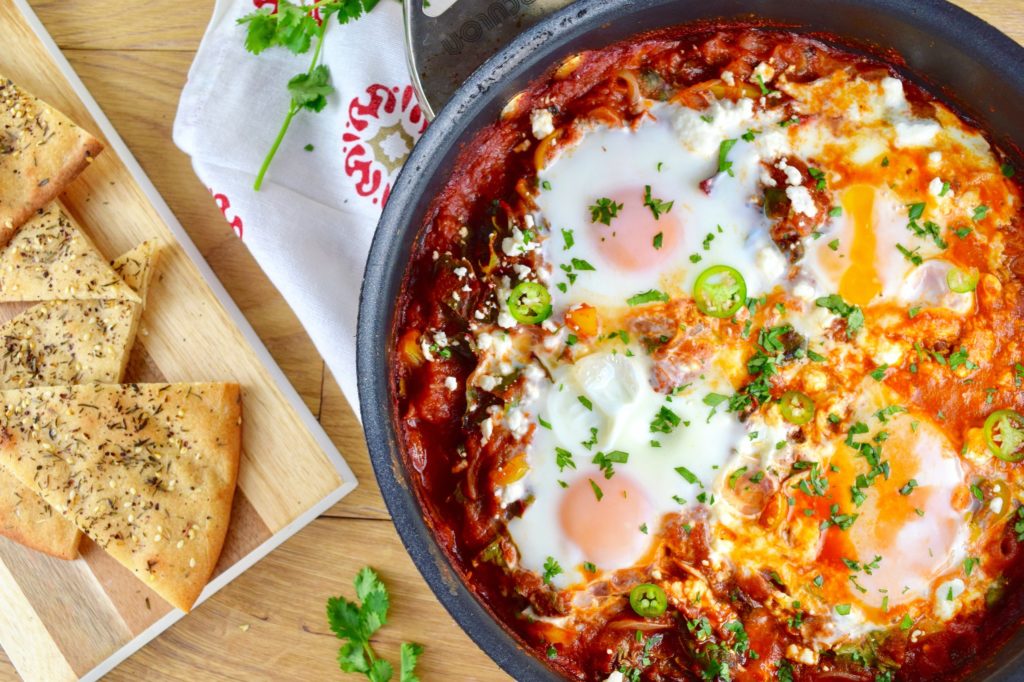
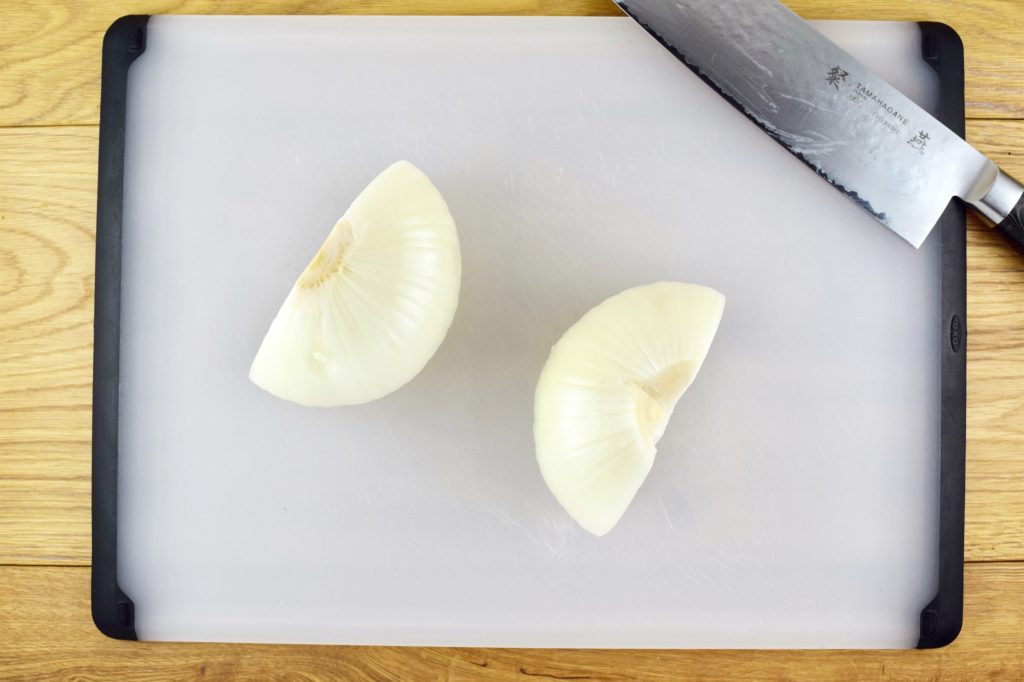
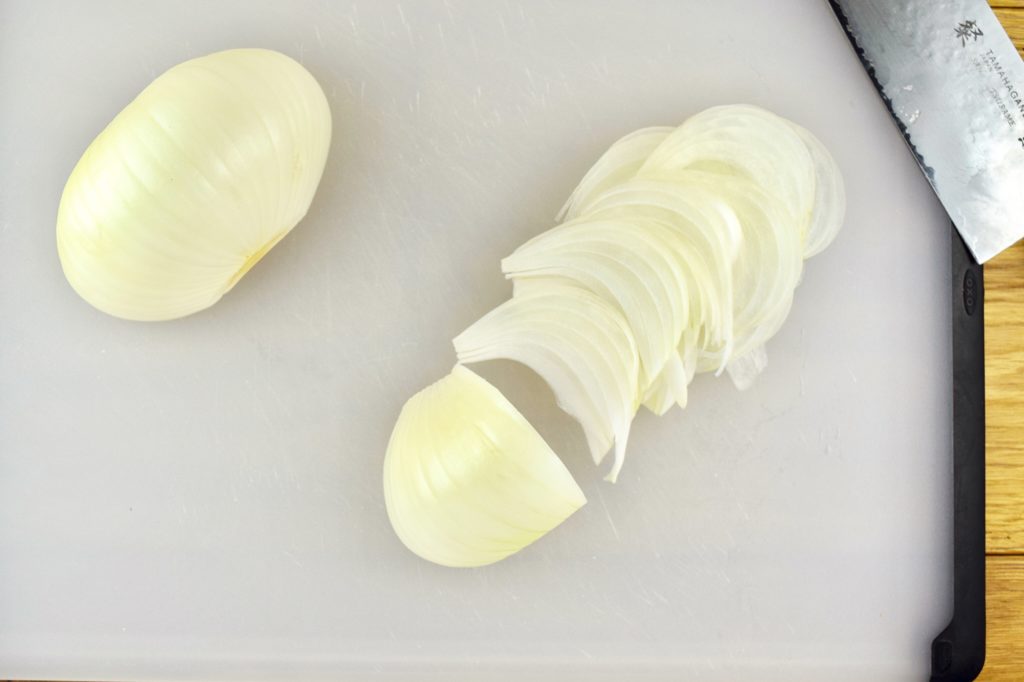
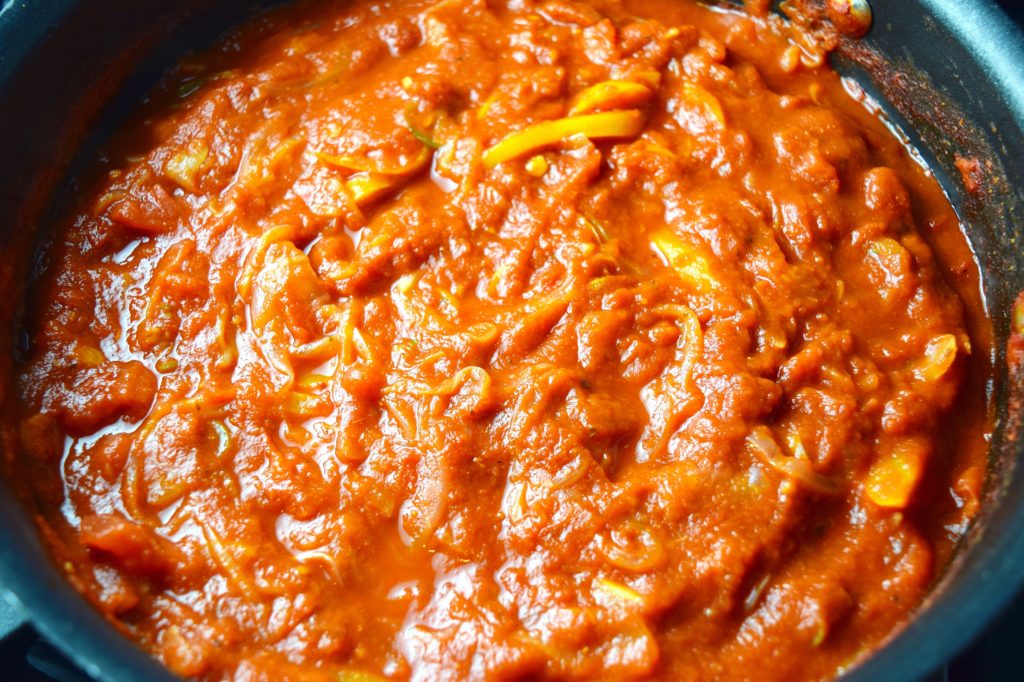
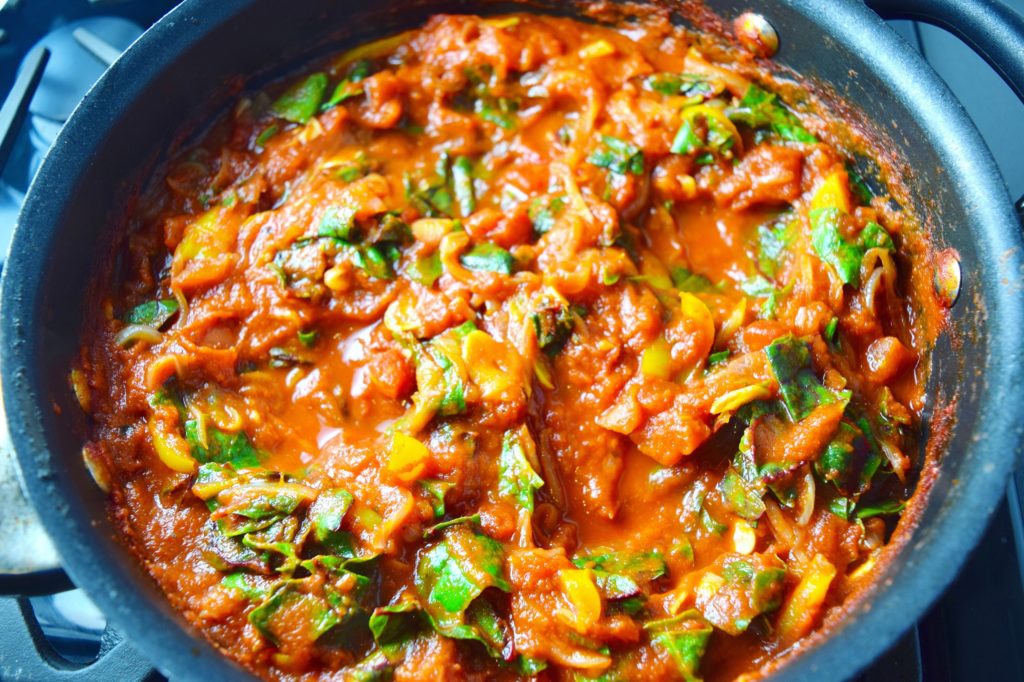
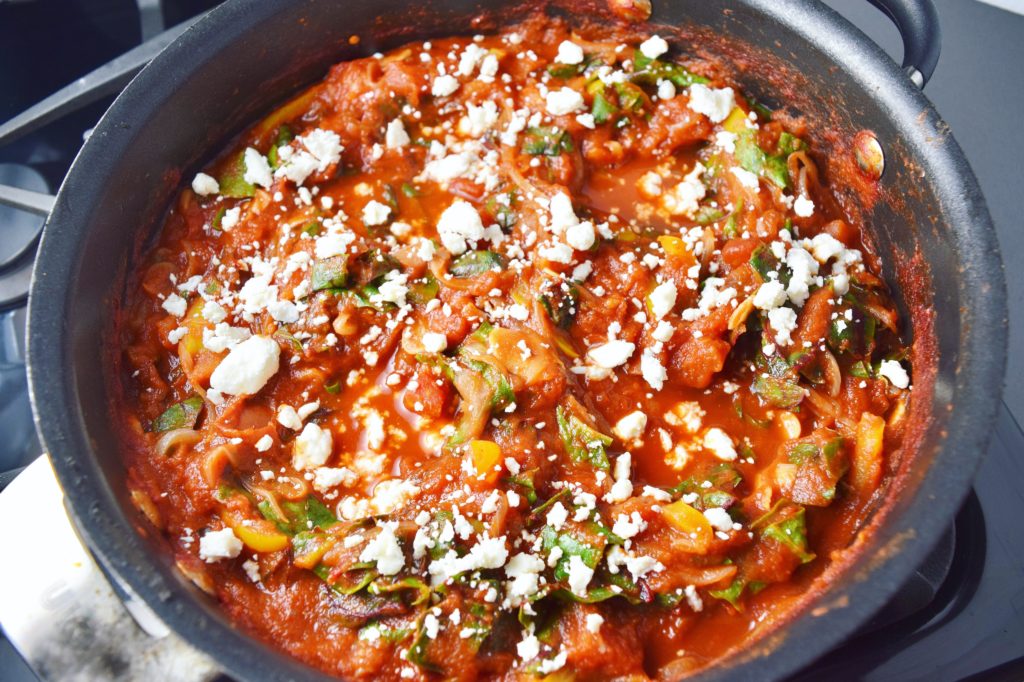
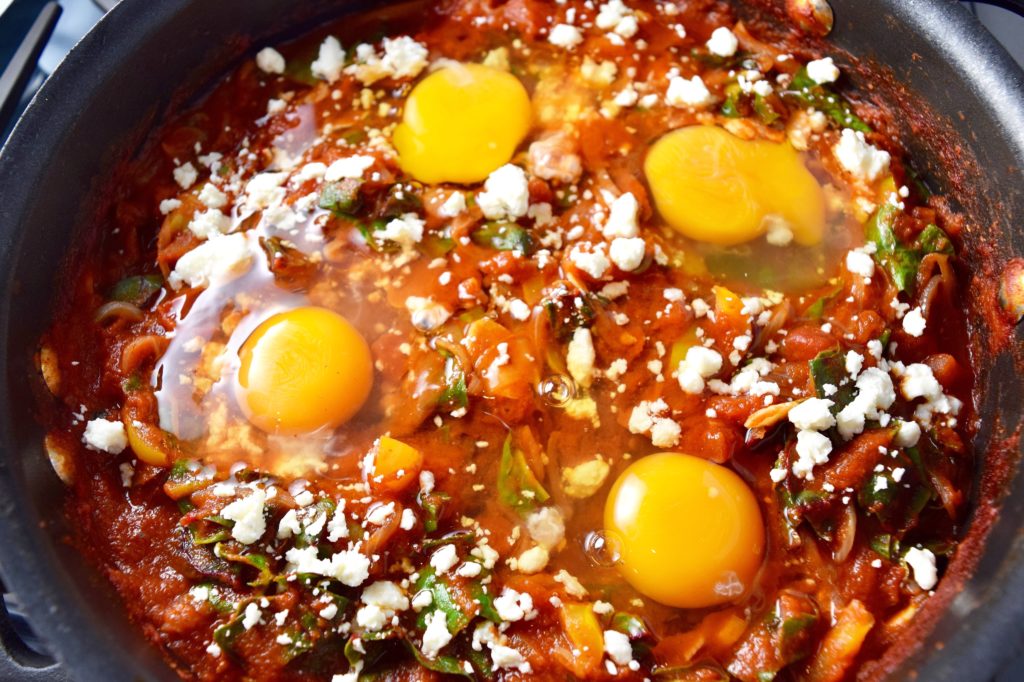
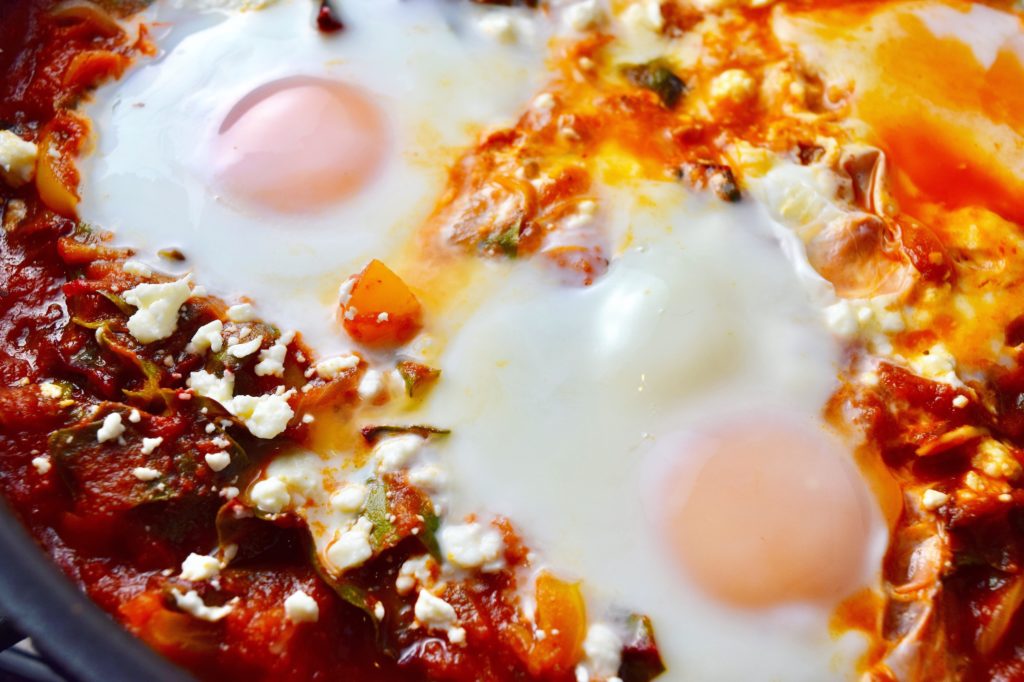
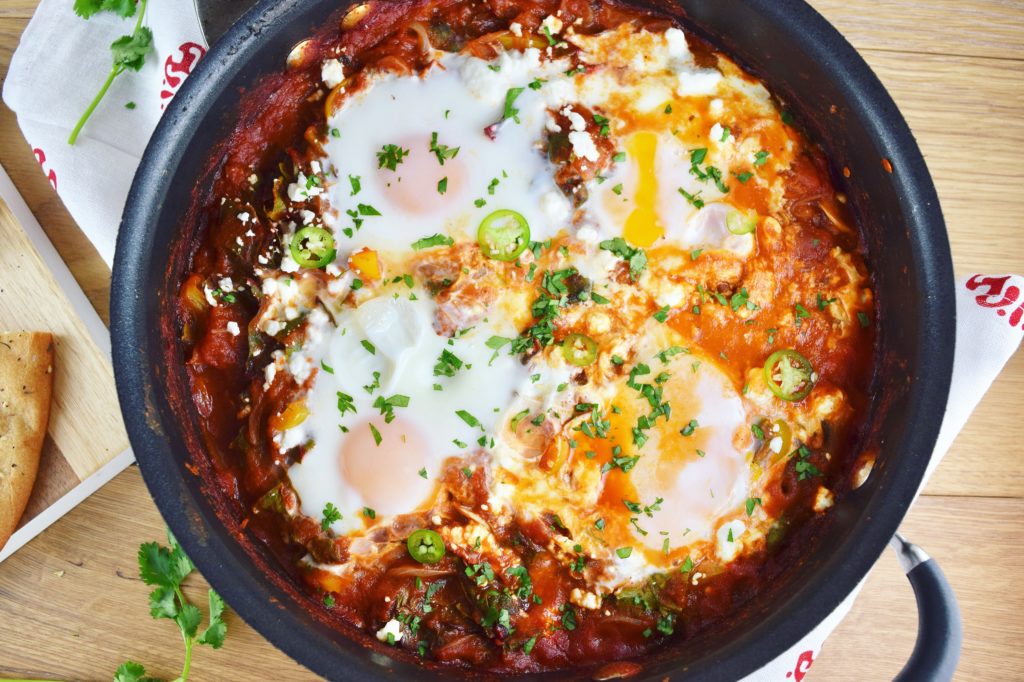
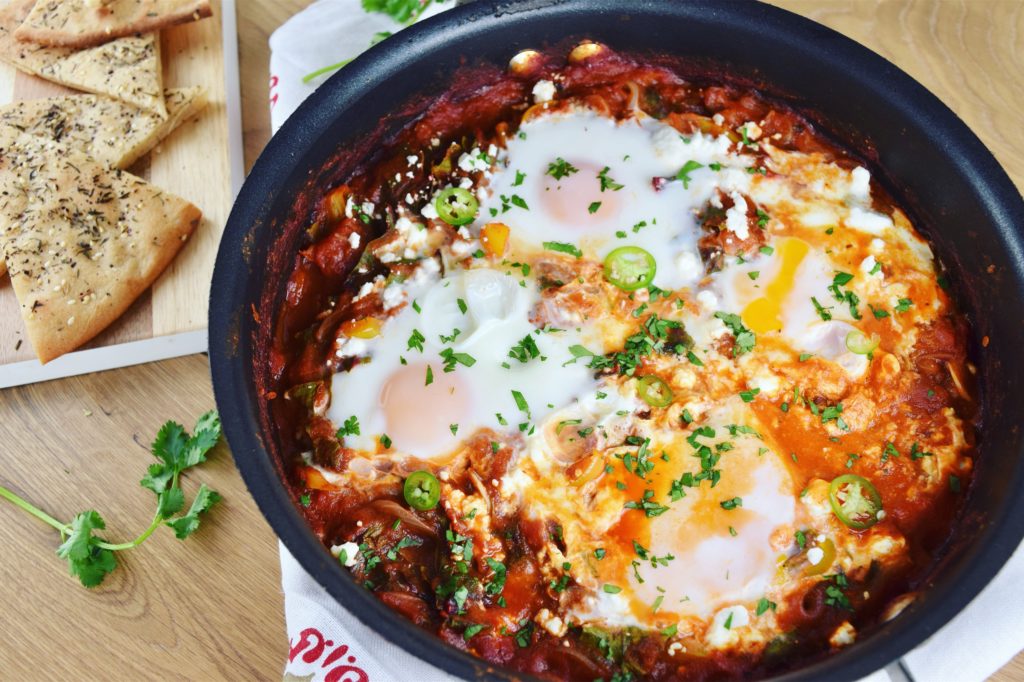


This is a fabulous dish & GHG’s version is our undisputed favorite. I can take it from minimal heat to full throttle depending upon who is at the table. Recently it was minimal heat as I had a heat adverse sister and 86 year old aunt as guests at our table. It got the highest accolade a dish can get: all our guests (4) asked for the recipe.
If you have folks who like eggs done to different doneness levels this works superbly with poached eggs placed on top of the plated Shakshuka.
Thanks for the glowing review Audrey! It really is one of my all-time favorite dishes, and I’m glad it’s now one of yours too. Enjoy!